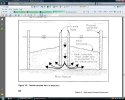- Joined
- Dec 9, 2010
- Messages
- 721
- Reaction score
- 3,472
Those are pre-built on land and assembled under and above the water.
Plus, it's not a zillion degrees Celsius in the lake, like it is in the reactors.
Those are pre-built on land and assembled under and above the water.
The first image at this link is the "leak"...
http://www.dailymail.co.uk/news/art...gineers-fail-seal-radioactive-ocean-leak.html
Army Corps of engineers PDF on underwater concrete
http://www.wes.army.mil/SL/INP/reports/inpsl1.pdf
They talk about minerals being added, and limestone
thermal behavior...

More than 50% over the limit, those mushrooms.
http://english.kyodonews.jp/news/2011/04/82903.html
TOKYO, April 3, Kyodo The health ministry said Sunday it has detected radioactive substances higher than the legal limits in mushrooms sampled Friday in Iwaki, Fukushima Prefecture, where the crippled Fukushima Daiichi nuclear power plant is located. The Ministry of Health, Labor and Welfare said it found the mushrooms to contain 3,100 becquerels of radioactive iodine and 890 becquerels of radioactive cesium against the limits of 2,000 becquerels and 500 becquerels. The announcement led the prefectural government to ask farmers to voluntarily refrain from shipping mushrooms in Iwaki.
Meanwhile, the science ministry said its helicopter, which examined air samples at the altitude of 160-650 meters, detected radiation of 0.30 microsieverts per hour in the sky above Kawamata in the prefecture -- a level more than 10 times the normal figures for the prefecture's sky at 0.01-0.03 microsieverts.
This sounds like a novelty item that was marketed as plant soil in the late 80's-early 90's. Can't recall the name. The selling point was that plants would grow for months without being watered. It was even available in a variety of colors you could match to your decor.From the article and here's the kicker, it sounds like they are trying an expanding foam. Trouble is, the wont how how it reacts to the water it's going into. Sounds like a hail mary pass to seal the leak.
Eighty bags of a water-gel mix made by the Tokyo-based IB Daiwa company will be used in the operation. Each one contains 100 grams of material that includes a special polymer. A Tokyo Electric official said the substance should expand to several thousand times its size as it sticks, ideally, to plug the leak.
http://edition.cnn.com/2011/WORLD/asiapcf/04/03/japan.nuclear.reactors/
Read this earlier this morning and I'm like, we'll see what kind of mud pit this makes. There is such a thing as preparing and roughing surfaces even for paint to stick. If this dosen't work, they will need to clean the pit out before trying another sealer.
Water is a problem in getting mixtures to set and harden. I knew concrete wouldn't set and harden in water, now they have concrete mud in the pit.
Cross your fingers on the foam expanding under water.
Respectfully snipped.BBM. Diapers and Paper mache...God help us all.
